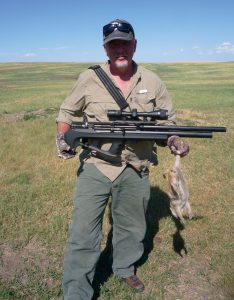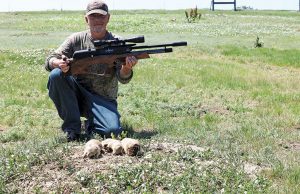If you follow the shooting sports, and I’m guessing you do, it’s hard to miss the immense popularity bullpups have been gaining. This trend also exists in the airgunning world, perhaps even more so. I’ll be up front: from an aesthetics perspective I’m more of a traditional sporter kind of guy, maybe a thumbhole stock if I’m feeling a bit wild; but from a function and performance standpoint, there is a lot going on with a bullpup that can translate into a great hunting platform. I’ve been using some of the best bullpup rifles over the last couple years, and I’ll share some of the general knowledge I’ve gained
before taking you into the field on a prairie dog hunt for a pragmatic look.
A bullpup (firearm or airgun) is a rifle that has its action moved behind the trigger. This allows a full-length barrel to be used, while effectively shortening the overall length of the rifle without shortening the barrel, as with a carbine. A trigger mechanism is typically deployed which links a surrogate trigger to the existing trigger assembly, and it takes a lot of care to optimize the design. This is especially true in rifles that are reconfigured into a bullpup from a standard long gun.
There are a couple of other considerations for airguns. The first is airguns need a reservoir of some type to store enough air to allow multiple shots. You don’t want the reservoir longer than the barrel, as this would defeat the purpose of the bullpup. The bullpup configuration allows the reservoir to be moved rearward with the action to maintain its alignment with the barrel. The second consideration, and a relatively tough one to address, is that almost all airguns need to be cocked for each shot. Unless there is some clever design work this moves the cocking mechanism back with the action behind the trigger.
 The features I look for in an airgun bullpup for hunting includes accuracy and appropriate power of course. But a compact, ergonomic and preferably lightweight stock are high on my list. A skeletonized stock helps reduce weight, with a well-proportioned forestock, pistol grip and adjustable buttpad facilitate a solid hold. With the action moved all the way back to the butt, many guns have the receiver exactly where the shooter rests his or her cheek.
The features I look for in an airgun bullpup for hunting includes accuracy and appropriate power of course. But a compact, ergonomic and preferably lightweight stock are high on my list. A skeletonized stock helps reduce weight, with a well-proportioned forestock, pistol grip and adjustable buttpad facilitate a solid hold. With the action moved all the way back to the butt, many guns have the receiver exactly where the shooter rests his or her cheek.
This can make for an uncomfortable cheekweld, especially in colder weather, and compromise the line of sight. For this reason, I give points to designs that have an integrated cover of the action to rest my grizzled face against, and even more if it is adjustable.
I prefer a multi-shot magazine that is auto-indexed by cocking the rifle with the cocking action in a location where I can cycle it without lifting my head.
This is ideally accomplished by moving the action forward with the trigger assembly. At any rate the action needs to be easy to cycle with a good tactile response. I want the barrel to be shrouded or incorporate a moderator. However, in most cases I prefer a shroud because it is very effective in quieting the gun but doesn’t add much to the overall length. Lastly, I want a secure, rapidly deployable carrying system because I often carry my varminting bullpups slung forward across my chest or on a three-point sling. A primary advantage of the design is that it provides the hunter with a compact rifle that’s easy to maneuver in thick brush, inside of a blind or other situations in which you need to make rapid adjustments in your position.
A couple of weeks ago I was invited to my buddy Brett Wiabels’ place in South Dakota to hunt some prairie dogs. I decided to make this a bullpup outing and for my multi-day trip brought three of my favorites: the FX Wildcat .25, the Hatsan Gladius .25 and the Air Arms Galahad .22. To my mind these guns represent the best of breed, and I was really looking forward to spending some quality field time with each.
The land I shot on had several prairie dog towns that ranged from a couple of acres to those spread out as far as the eye could see. There are expanses of flat and unvarying grasslands and areas of rolling hills that always seem a lot steeper when hiking up under the scorching sun than they appear in photos! Unlike shooting prairie dogs long range with a centerfire from a stationary position, with airgunners “long range” means out to 125 yards. The shorter distance puts you on the ground hiking, crouching and crawling to close the distance. It’s why I love going after these burrowing rodents with air power; each shot can be a mini spot-and-stalk hunt with never-ending opportunity! This would make a proper test for the bullpups — miles of hiking while carrying all the requisite gear (water, pellets, sticks, binoculars, range finder, cameras … and more water) and shooting from just about any awkward and convoluted position you could imagine.
When I got to the ranch it was hot and muggy due to several downpours. At times it was also very windy. The weather made for challenging conditions on one hand.
I grabbed the Air Arms Galahad for my first outing because its the one I’d used the least. On the bench and plinking I found the gun offered several of the fundamentals and features I mentioned — accuracy, power, effectively shrouded, very shootable and fast to cycle. The Galahad implements a unique side-lever cocking mechanism in which the lever is pushed down and pulled up to cycle. The position of the lever has been moved forward of the trigger group which allows it to be worked without taking the gun
off target.
 With this rig I hiked about a mile up and down the grassy hills from the road to a small town, where I crawled over a rise on my belly and settled in under a barbed wire fence. I shot from both a prone and sitting positions and selectively popped about a dozen dogs as close as 25 yards and as far as 100. With head and body shots, the .22-caliber JSB Round-nose pellets effectively dropped dog after dog. The gun’s report is very low. Being able to quickly cycle the gun without a lot of extraneous movement let me get several multiples. I also adjusted for the wind when blown off course and made the fast follow-up shot.
With this rig I hiked about a mile up and down the grassy hills from the road to a small town, where I crawled over a rise on my belly and settled in under a barbed wire fence. I shot from both a prone and sitting positions and selectively popped about a dozen dogs as close as 25 yards and as far as 100. With head and body shots, the .22-caliber JSB Round-nose pellets effectively dropped dog after dog. The gun’s report is very low. Being able to quickly cycle the gun without a lot of extraneous movement let me get several multiples. I also adjusted for the wind when blown off course and made the fast follow-up shot.
I went out with the Hatsan Gladius the next day. My gun is a .25 though it comes in calibers ranging from .177 to .35. This is the largest and heaviest of the three guns, however that statement is a bit deceptive in that with the balance of the gun it carries and shoots very comfortably. One thing about bullpups in general is they seem to pull the gun’s weight into the shooters center of gravity, which in my opinion helps to stabilize them for offhand shooting. I spent the day hiking, crawling and anchoring prairie dogs all over the property with this rifle. The things that I really appreciated were the accuracy and high power (which is adjustable), effective shroud and a side-lever action that is moved up well in front of the trigger. This is something I didn’t expect to find in a gun at this price point, which more than made up for the little bit of extra weight to my way of thinking.
I found a single tree in the middle of the waving grass, sat under it and shot the Gladius off my knee. I was taking prairie dogs out at 75 yards and the big 25-grain .25-caliber pellet was knocking them over with authority. When I blew through my first nine-shot magazine, I pulled the magazine out and replaced with another fully loaded one. The gun has storage slots in the stock that hold three additional magazines (that come with the rifle).
My last prairie dog day before switching over to hunt coyote (that’s another story) was spent with not only one of my favorite bullpups but one of my favorite air rifles: The Swedish-made FX Wildcat. This rifle is an example of superb design and execution in manufacture. One of the most accurate airguns I’ve shot, it is lightweight, ergonomic, powerful, the side lever has a silky smooth action and the trigger is close to perfection. The only downside is the price tag, which will put this gun out of the reach of many buyers.
For this rifle I focused on long-range shooting and took it on a day with very little wind. Both from sitting, shooting off sticks and prone off my pack, I was sending the .25-caliber pellets out to 130 yards, silently dropping one dog after another.
So what did my few days of bullpups and prairie dogs tell me? First was that reducing weight is nice in a setting where you’ll be hiking long distances.
However, with all the gear I was packing it was the compactness and size of the gun that made a difference. I also found the short overall length made shooting in more constrained spaces easier. That also made it easier to move around when setting up. Prairie dogs offer a target-rich environment, and a gun that lets you cycle rapidly without breaking your line of sight is advantageous. Also, all these guns provide at least 40 shots per fill, so I didn’t have to carry an extra air tank or hike back to the truck for a refill.
You obviously don’t need a bullpup to effectively hunt prairie dogs with an airgun, but I will say that the design does lend itself to this type of field work.
If a hunt requires you to cover long distances, pack a lot of gear, shoot from awkward and tight spaces and do so without compromising performance, this style of gun has much to recommend it.






